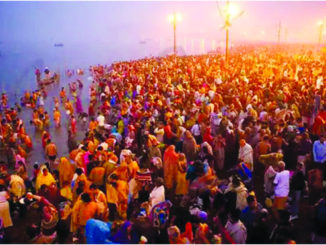
Tirumala Sri Venkateswara Temple at Tirupati in the Indian state of Andhra Pradesh is one of the most famous Vaishnavite temples in the world. The presiding deity of Vishnu here is referred to as Venkateswara. There are many legends regarding this temple. Sri Venkatachala Mahatyam is the most accepted legend among these, which provides the history of the temple across the various yugas. This place had also been mentioned in many puranas.
As per Varaha Purana, during Satya Yuga, Vishnu rescued Earth which was taken over by Hiranyaksha to Patala Loka (underworld) in the form of Adi Varaha – a wild boar with tusks. He fought a fierce duel with Hiranyaksa and killed him. He then slashed the water and brought up the Earth on his tusks. Brahma, the Devas and the sages extolled Adi Varaha’s virtues, by chanting the Vedic mantras. They prayed to Him to re-establish the Earth as before. Adi Varaha obliged them, and called upon Brahma to recreate the world. He expressed his desire to reside on the Earth to protect its people. He commanded his vahana, Garuda to fetch Kridachala (an extensive natural hill with lofty peaks, embedded with gold and precious stones, and which resembled Adisesha in shape) from Vaikuntam. Garuda brought Kridachala and deposited it on a sacred spot (to the East of Swami Pushkarini) chosen by Adi Varaha. Brahma and the other holy personages requested the fearsome-looking Adi Varaha to assume a tranquil and composed look, and rest on the hill to protect men and grant boons to people unable to reach God through Dhyana Yoga (meditation) and Karma Yoga (doing one’s own duty). Adi Varaha appeared with four arms and a white face. He was adorned with jewels and accompanied by Bhudevi. He resolved to stay at Venkatadri, under a divya vimana, to grant the prayers of men.
It is believed that the origins of the Tirumala Hills (Seshachalam Hills) lies in a contest between Vayu (the wind god) and Adisesha (the first serpent). During Dvapara Yuga, Adisesha blocked Vayu from entering Vaikuntam as Lord Vishnu was in the company of his consort, Lakshmi. An incensed Vayu challenged Adisesha to a fight to decide the stronger between them, Vayu was tasked with trying to blow off Adisesha from the holy Meru mountain while adisesha was asked to protect the peak with his hood. After a long time, Vayu appeared to yield and Adisesha lifted his hoods assuming that he had won the contest. Vayu then blew away one of the peaks. The peak landed near the Swarnamukhi river and is currently known as Seshachalam hill
A variant to the legend is that the contest created pandemonium on earth and Brahma, Indra and other gods pleaded with Adisesha to relent. When Adisesha obliged, the peak (Ananda hill) and Adisesha were blown off Meru and landed near the banks of river Swarnamukhi. When Adisesha was dejected with his defeat, the Gods converted Adisesha into the seven hills with the hood named as Seshadri hill or Seshachalam hill or Venkatadri hill. Another variant to the story is: Adisesha, fatigued by the contest was instructed by Lord Vishnu to rest on Earth in a place that he chose for his stay in Kali Yuga.
In the Kali Yuga, rishis performing yagna sought the advise of celestial sage Narada on which of the Trimurti should be selected for offering the fruits of the yagna. Narada suggested that the wise sage Bhrugu should be allowed to decide after he met the Trimurtis. The sage who had an extra eye in the sole of his foot visited Lord Brahma and Lord Shiva and went un-noticed in both these locations. He cursed Brahma that no temple sans one will worship Brahma and cursed Shiva that temples on Earth will worship him as Lingam.
When Bhrigu visited Lord Vishnu who was in a private meeting with his consort Goddess Lakshmi and failed to immediately receive and honour the sage, the sage felt humiliated and angry by this act. Sage Bhrigu kicked Lord Vishnu in the chest, to which Vishnu did not react and instead apologized to the Sage by massaging his feet. During this act, he squashed the extra eye that was present in the sole of Bhrugu’s foot. The extra eye is believed to represent the sage’s false egotism. The sage then realised his grave mistake and begged forgiveness from Lord Vishnu. Lord Vishnu’s chest is significant as the abode of Goddess Lakshmi, the Goddess felt highly insulted at the sage’s misdemeanour and Lord Vishnu’s silence at the act and left Lord Vishnu’s heavenly abode (Vaikunta).





Be the first to comment